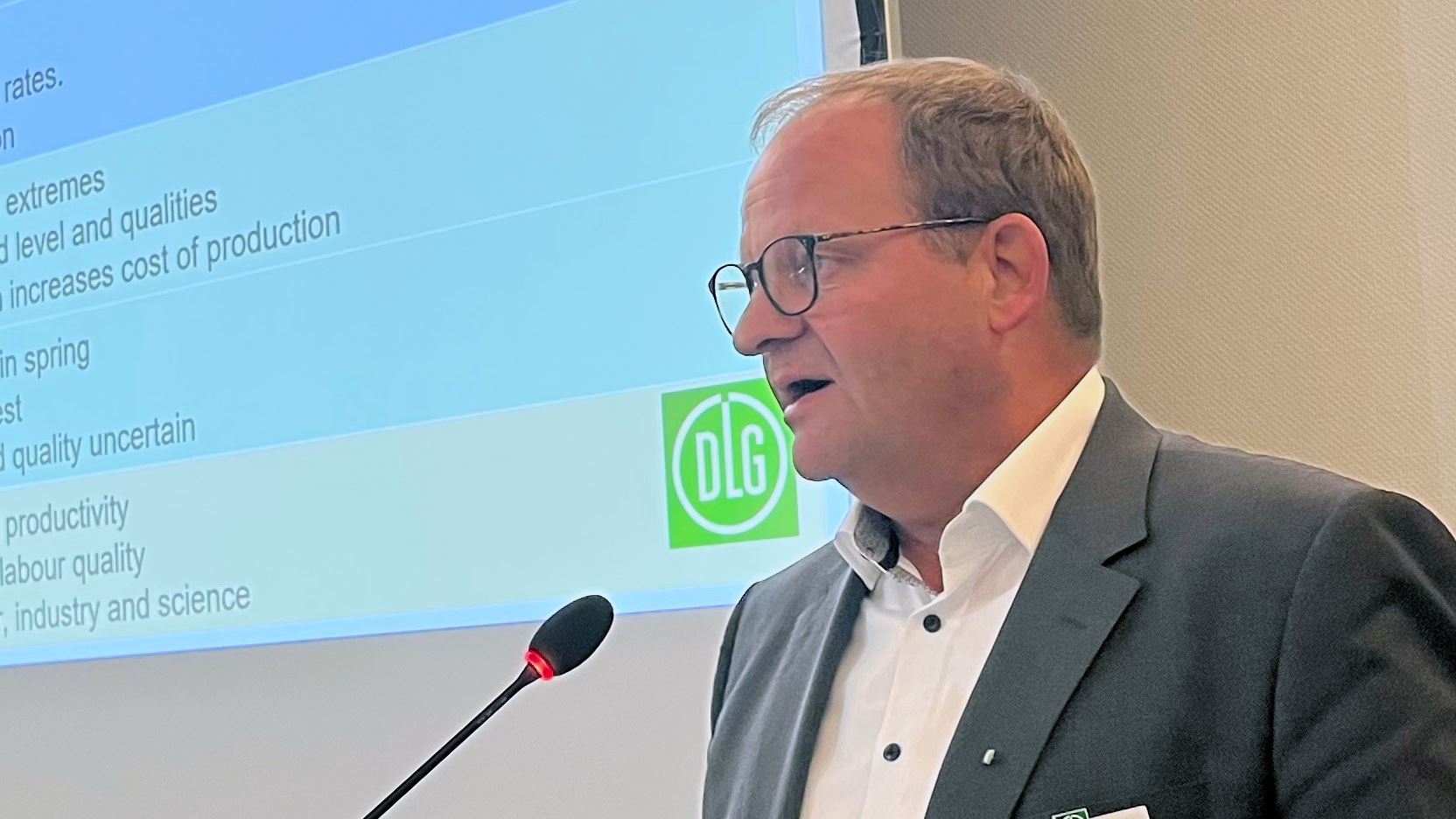Influence of climate change evident - German and European agricultural policy in upheaval - farms planning investments
Dr. Lothar Hövelmann, Chief Executive Officer, DLG (German Agricultural Society), Frankfurt am Main, Germany
(DLG). The DLG (German Agricultural Society) invites the international agricultural industry to the world's leading trade fair for agricultural machinery, Agritechnica, - in Hanover, Germany, from November 12 to 18, 2023. With more than 2,600 exhibitors from 53 countries, Agritechnica is taking place for the first time as an in-person trade fair, since the pandemic began, offering a high number of exhibitors and a wide range of products and services, as it did in 2019. The general conditions facing the industry though are still not simple: For example, the effects of Russia‘s war in Ukraine also represent a new epoch for both global agriculture and all agricultural machinery manufacturers. Additionally, the effects of climate change are becoming increasingly evident, the Green Deal and the upcoming changes to the Common Agricultural Policy (CAP) are casting their shadows, and the situation on the financial markets – in particular interest rate policy - results in a challenging environment for investment.
Influence of weather and climate ever stronger
In recent years, the number of extreme weather events has increased in many regions around the world. The planet is currently experiencing the hottest three-month period on record, with unprecedented sea surface temperatures and extreme weather events. Global temperatures were about 1.5 °C warmer in August 2023 than the pre-industrial average, and the past nine summers have been the warmest on record. Despite the cool rainy period in July, the summer of 2023 continues this trend. This situation leads to increasing uncertainties in yield and quality of agricultural produce. Furthermore, operational measures for adaption to the changes in climate, such as irrigation, will further increase production costs in the long term.
In Europe, the pre-summer drought has posed significant challenges to crop production. In mid-June 2023, the western Mediterranean experienced drought that was even more severe than in 2022, while further east, including Italy, recovered reasonably after a critical early spring. Nevertheless, the drought in Europe was worse in 2023 and 2022 than in 2021, with the exception of northern Scandinavia.
In August 2023, a pre-summer drought was followed by a significant weather change, hampering harvesting in Europe. The different weather extremes in wet and dry areas impacted summer and winter crops. Heavy rainfall, thunderstorms and hailstorms caused significant damage in northern Italy, Slovenia and Croatia.
Agriculture will have to face major challenges in the future:
1. Water management must be optimized and, consequently, new tillage strategies must be adopted.
2. Crop breeders must focus on new cultivation and breeding methods.
3. Climate change will lead to adjustments to crop rotations and more efficient use of inputs.
4. Overall, significant investment in climate adaptation will be required.
What is the market situation?
The global markets for wheat are characterized by tight global supply, lower trading activity and lower stocks than usual. Consumption is higher than production. The declining production in the EU, Canada and China are only partially offset by increases in Ukraine and Kazakhstan. This means that grain inventories of important exporters are declining. With the expiration of the Black Sea Grain Initiative, Ukraine's exports remain unchanged at just 10.5 million tons.
The global trade in cereals is almost balanced, although stocks are still rather low compared to previous years. The balances, excluding China, show a slight easing, but stocks remain at a low level. At present, there is no sign of lower prices.
The wheat price on the Matif fell again after prices were very high due to speculation and uncertainty at the start of Russia's invasion of Ukraine. There is a great deal of uncertainty for further price developments – grain sales are therefore a difficult business for producers to calculate.
Milk prices declined in 2023, starting from a very high level. The Global Dairy Trade (GDT) milk price index in August reached its lowest level in five years. Producer prices will follow this trend, which will ultimately have an impact on the market for green fodder technology.
Farm investment intentions in Europe
In August 2023, DLG surveyed more than 2,300 European farmers on the business climate and their investment intentions as part of a "Short Study Agrifuture Insights." The arable farms mostly assessed their operational situation as economically good, while they considered the future business environment tob e less favourable. Among pig farms, the current business situation is viewed positively, a result of higher prices, but there is a lack of stable general conditions for further operational development. Overall, the missing impetus is holding back the business climate.
Among dairy farms in the survey, many are burdened with high debt servicing and higher interest rates following significant expansion investment. With lower producer prices, this has resulted in lower liquidity in 2023 compared to the previous year.
In particular, arable and pig farmers see increasing regulation and agricultural policy as the biggest challenges to their business. For arable farmers, climate change is considered a similarly significant challenge, not to mention cost increases for inputs and arable land. In livestock farming, future interest rate developments will have an impact on refinancing and short-term financing lines.
Where are investments coming up?
Nearly half of respondents stated that they plan to invest in a new tractor in the next two years. For agricultural machinery, particularly attachments, the respondents are primarily concerned with technologies such as precision farming and automation.
What innovations are in demand in arable farming?
Energy efficiency is the focus of all the groups in the survey, as costs have an enormous influence on the bottom line. The above-average interest slurry innovations shows that environmental protection still requires further technological advances.
Smart farming and precision farming are in the focus due to rising input costs. Innovations that optimize input usage are needed. Also as a result of increasing regulation, respondents want to increasingly focus on efficient and targeted use of inputs and resources.
Mechanical crop protection is increasingly becoming part of crop cultivation strategies, either replacing or supplementing chemical crop protection.
The ongoing topic of interoperability and compatibility between networked agricultural machinery is rated as far more important by respondents from consulting, research and industry than by farmers. According to feedback in the survey, the latter seem to be losing interest in the topic, as it takes time for research findings to be satisfactorily implemented in practice. Even today, many solutions only work partially; there are still problems with data aggregation and processing. Nevertheless, "Big Data" and artificial intelligence (AI) are seen as future innovations for agriculture.
In general, respondents would welcome innovative technical solutions in areas that are becoming increasingly regulated, particularly crop protection. However, respondents also expect more innovative solutions from plant breeding for climate adaptation and plant diseases (resistance). The development of new technologies in the area of fertilizer management is prioritized somewhat less by the respondents compared to these topics.
The need for innovations in sensor-based systems and improvement of data management is rated less important by farmers than by respondents from extension services, science or industry. According to responses, more operator training would be needed and functionality often still needs improvement.
There is currently a high political interest in new solutions for mechanical crop protection and therefore practitioners see a need for additional development in this area.
Evaluation of green measures in arable farming
In arable farming, many "green measures" are already being implemented today to use resources efficiently and to adapt to climate change. More than two-thirds of respondents have extended their crop rotation, with a some further 20 percent planning to do so. More than half are already using diesel conservation measures, while a further 40 percent intend to do so. Site-specific application of inputs is already in practice at 38 percent of the farms surveyed, and another 40 percent are planning such measures. Water management is already a day-to-day operational issue for one third of respondents, while 40 percent will require measures in the future.
Conclusion
Agricultural businesses in Europe are already facing up to the effects of climate change or are preparing for them. Over 90 percent plan to invest in new technology in the next two years. They are adapting their farming strategies to rising inputs costs, using them more efficiently thus maintaining productivity.
Agritechnica 2023 will cover this topic comprehensively in its technical program with its guiding theme "Green Productivity" and, with many discussion events, spotlights, „expert stages“, will share practical know-how and thus enable tailored decisions for future-proof investments.

